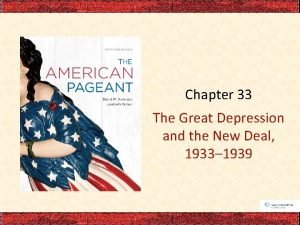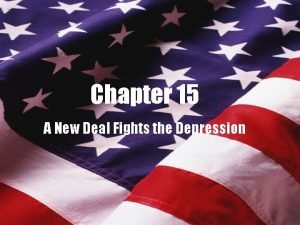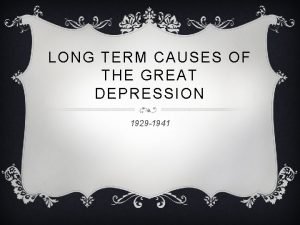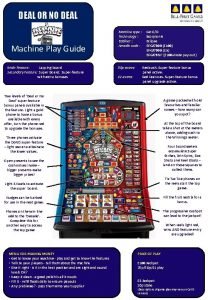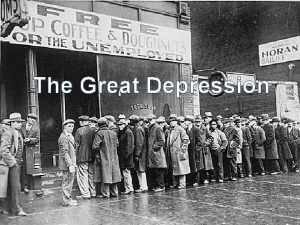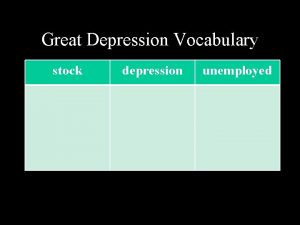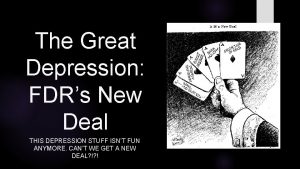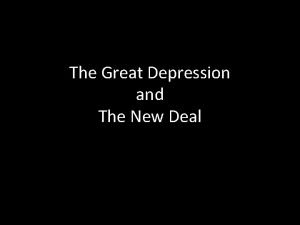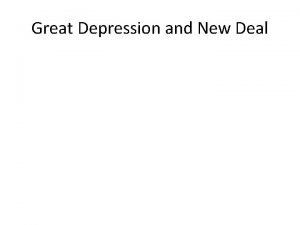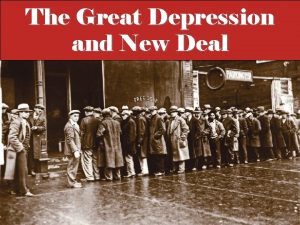Great Depression and New Deal Causes of Great









- Slides: 9

Great Depression and New Deal

Causes of Great Depression • • Unequal Income—businessmen and professionals made large sums of money; workers’ wages did not increase as fast as the price of goods; consumer spending then dropped. Stock Market Speculation—during the 1920 s the US experienced a bull market (stock prices rising); – investors bought stock on margin (credit), paying as little as 10% down and borrowing the rest of the money; – when the stock market crashed, stock prices fell, and investors could not regain their money – Stock brokers could not repay loans to banks – People worried that their savings would not be in banks and rushed to withdraw their money forcing banks to close – Businesses could not borrow money to operate or expand eventually closed – Workers lost jobs, and unemployment skyrocketed. • • Collapse of Farm Economy—farmers produced more food than consumers needed; prices dropped, and farmers could no longer pay to operate their farms. Great Depression began in the US with the stock market crash on October 29, 1929 (Black Tuesday) and soon spread worldwide.

Dust Bowl • From 1933 -1936 land from Texas to the Dakotas received little rain; • soil erosion took place as winds spread the dry soil • Dust storms blew away the topsoil • Many farmers left this “dust bowl” to move to the Pacific coast

Southern Appalachian Region and Tennessee Valley • One of the nation’s poorest areas • Hard hit by the Depression

Herbert Hoovers’ Administration (1929 -1932) • Republican president when stock market crashed and Great Depression began. • He was often blamed for the nation’s economic problems. • He did very little to help the nation’s problems, believing that it was not the job of the government to assist the needy, but the job of the poor to help themselves or get help from family, friends, church or charities. • He even had the Army break up, by force, a camp of WWI veterans who had marched to Washington to demand a war bonus for their service • By the election of 1932, Hoover was very unpopular and lost the election in a landslide to Democrat Franklin D. Roosevelt.

Franklin D. Roosevelt and The New Deal • FDR brought hope and optimism to the nation in the worst years of the Depression. • He was the only man ever elected to 4 terms as President— 1932 to 1948; he died in 1945 and did not finish his fourth term. • He pledged to use the money and resources of the national government to help the nation, boost the economy, and put the unemployed back to work—this plan became known as the New Deal. • The New Deal was based on the 3 R’s: – Relief--direct payments or jobs for the unemployed, loans to farmers and homeowners – Recovery--Aid to farmers, business owners, and workers to get people back to work; the government provided many jobs for people in building roads, highways, public buildings, dams, and national parks—these projects are known as public works. – Reform—measures to regulate business and banks and the stock market to make sure there would not be another depression; these measures protected bank depositors, investors, consumers, the elderly, children, and the unemployed

Major New Deal Legislation • Federal Deposit Insurance Corporation (FDIC)— 1933; – insured depositors up to $100, 000 in case of bank failure; – to prevent people from withdrawing money from banks if they were in danger of closing • Social Security— 1935; provided retirement income for all workers once they reach age 65. • National Labor Relations Board (NLRB)— 1935; also known as the Wagner Act; created a board to monitor unfair management practices such as firing workers who joined unions. • Works Progress Administration (WPA)— 1935; – provided jobs for unskilled workers who had no job; – at one time 1/3 of the unemployed in the nation worked for the WPA (3. 2 million); – WPA workers constructed many government buildings in the 1930 s.

Major New Deal Legislation • Civilian Conservation Corps (CCC)— 1933; – provided jobs for unmarried men from 17 -23; • worked in national parks installing electric lines, building fire towers, and planting new trees. • Fair Labor Standards Act— 1938; – raised minimum wage to $. 40 an hour; • set work week at maximum of 44 hours; • ended child labor under age 16. • Tennessee Valley Authority (TVA)— 1933; – built hydroelectric dams to bring electricity to new areas of the South, including North Alabama; – Provided employment and cheap electricity to a historically poor area – The TVA brought new prosperity to the region – Several dams and power plants were built in Alabama – This agency still functions well today.

Cultural Developments During the Depression • Popular entertainment included movies – Snow White and Seven Dwarfs, Wizard of OZ (first color film) and Gone With the Wind and radio programs and news broadcasts – 1930 s and 1940 s considered the “golden age of radio” • Fireside Chats—President Roosevelt’s radio broadcasts to the nation. • Homelessness—jobless people wandered from town to town, looking for work; many lived in communities of tents and shacks named “Hoovervilles” after President Hoover. • Malnutrition—especially among children; malnutrition rate rose from 18% to 60%; charities started soup kitchens to feed the hungry; the thin soup served became known as “Hoover Stew”
 Vocabulary review causes of the depression
Vocabulary review causes of the depression Us history eoc review the great depression and the new deal
Us history eoc review the great depression and the new deal Chapter 33 the great depression and the new deal
Chapter 33 the great depression and the new deal A new deal fights the depression
A new deal fights the depression Chapter 15 section 1 a new deal fights the depression
Chapter 15 section 1 a new deal fights the depression Great depression causes
Great depression causes What were the long term causes of the great depression
What were the long term causes of the great depression Deal or no deal machine
Deal or no deal machine Asset deal vs share deal
Asset deal vs share deal A great deal vs a great many
A great deal vs a great many


